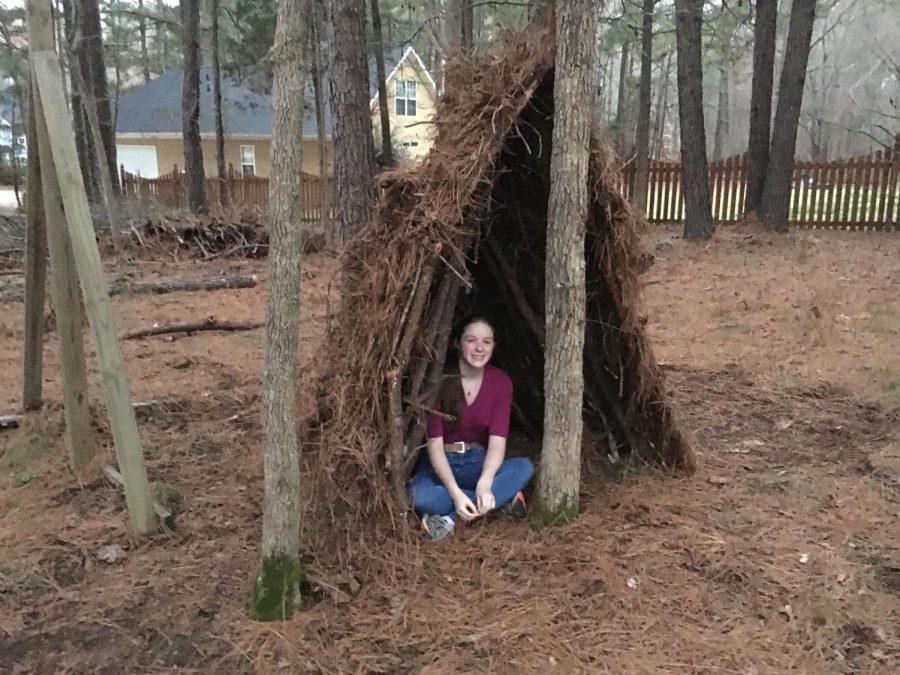Opinion: Lack of survival skills may lead to human downfall
Sitting in a survival shelter I made in my backyard. Survival shelter building is one of many essential skills students could learn in a course designed to help with emergency preparedness.
The world has gone corrupt and everything we used to have, electricity, appliances, housing, and available sources of food, have all been taken away. Now, all we have left is abandoned buildings and nowhere to go. What do we turn to? Nature, the only place left.
This situation might seem a bit far fetched whereas situations such as going on a hike and getting lost are much more realistic. Sure, we have search and rescue teams, but what are you going to do on the days you are not found?
For most people, specifically young adults and teenagers, if they were put into this situation, they would not survive. Why? The surge of mainstream media and availability of technology, and a general lack of knowledge.
Say mankind was put into a situation where we had to live in the wild and survive only off of what was already there. Only a small percentage of people would know what to do.
How do you make a shelter? What plants can you eat? How do you hunt? How do you set traps? What happens if an injury occurs?
In the Boy Scouts of America, scouts are required to earn the “Wilderness Survival” merit badge. Scouts learn how to build shelters, start and maintain fires, perform first aid, and a multitude of other survival basic skills.
There are also other aspects of BSA that teach scouts aspects of wilderness survival: identifying poisonous and venomous animals and plants, various methods of gathering food, and how to cook and dry food.
In the world, there are 54 million active scouts. Assuming that these scouts have received the Wilderness Survival merit badge and are competent in wilderness survival skills, we can assume that out of the entire world population (7.9 billion), only 7% of the population would survive a world where we had to live like our ancestors.
There are many exceptions that can increase these odds. People such as BSA alumni, bushcrafters, professional survivalists, and the fact that those who would know how to survive can teach others, increases the odds to about 9-10%.
How do we prevent this total world collapse? We cannot really, but we can take steps to ensure success of survival if it ever happens.
One of the best ways is to create survival training programs and courses in high schools and colleges. In these classes, people would learn the five basic survival skills: how to build a shelter, how to perform first aid, how to find food, how to find safe water, and how to start and maintain a fire. They can also learn how to cook, how to signal for help, and how to read maps and compasses.
These classes would most of the time take place outside, so a large classroom is not needed. It should also be noted that each course would be specific to its location and climate. For example, a class taught in Georgia would focus more on surviving in wet and moderately warm temperatures in forests, grasslands, and mountains. Classes taught in the northern states would focus more on surviving in cold and snowy areas with ice and mountains.
Most kids are what environmentalist Richard Lou would call “Nature Deficit,” so stuck in the virtual world that they rarely take time outside.
One key thing that can be done to prevent this for young kids and the future generation is to get them outside at an early age. Partake in activities with them, get them involved with nature and organizations such as Cub Scouts and BSA. Show them how they can benefit from nature. The more time spent outdoors, the more they will develop their connection with nature and be more interested in it.
As doable as this is, multiple problems arise. Places that would benefit and need it the most, such as cities, do not have natural areas that they could use. A good solution to this problem would be to replace an area that is not used as much, say a parking lot, and replace it with grass, trees, leaves, moss, dirt and other natural resources.
The average city parking lot is about 320 square feet. The cost to replace the parking lot is about $2-5 per square foot. Assuming the cost of purchasing naturalities is added, the total cost would be a little over $2,000. A space that has enough room for students to build shelters and make campfires would be sufficient for learning the basic skills.
In reality, it is a doable thing, but getting it done may take a long time. However, the end result will create life-long preparedness for those willing to learn.
Opinions expressed in editorials are those of the writer(s). These views may not represent the adviser, The Prowler, advertisers/sponsors, the Starr’s Mill High School administration or staff , or Fayette County Public Schools as a whole. Please see our FAQs for more information pertaining to the rights of The Prowler’s staff members.



Mr. Kendall • Feb 28, 2022 at 11:37 am
Love it! Couldn’t agree more! Great job, Adeline!